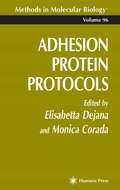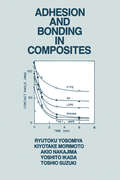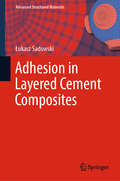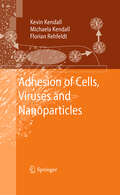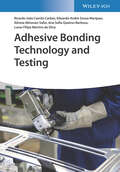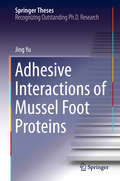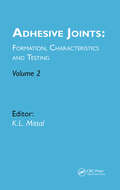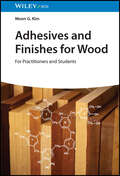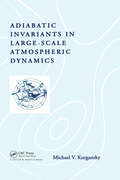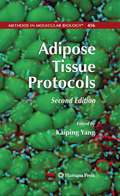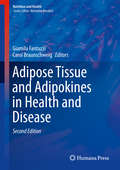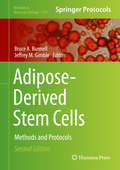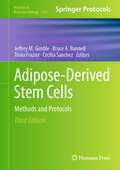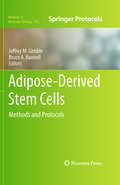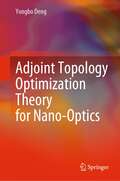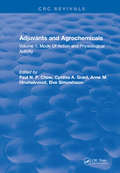- Table View
- List View
Adhesion Protein Protocols (Methods in Molecular Biology #96)
by Monica Corada Elisabetta DejanaAn international corps of expert investigators describe their optimized techniques for both the identification of new cell adhesion proteins and for the characterization of novel adhesive structures. Their cutting edge methods will enable both novice and experienced researchers readily to identify and clone new adhesion proteins, to successfully produce inhibitors of the adhesive activity, to develop biological models for the assay of cell-to-matrix and cell-to-cell adhesion in vitro, and to measure the signaling activities of adhesion proteins. By illuminating these adhesive molecules and the possibilities for manipulating them, the new experimental strategies collected here will have considerable clinical potential for the regulation of immunity, inflammation, tissue remodeling, and embryonic development.
Adhesion and Bonding in Composites
by Ryutoku YosomiyaThis book deals with the roles played by the component material interface in composites, with special emphasis on methods used to improve the adhesion and bonding between them. It is helpful for scientists and engineers in the materials field and to engineers working with adhesives or composites.
Adhesion in Layered Cement Composites
by Łukasz SadowskiThis book discusses how to identify the level of adhesion in layered systems made of cement composites using a multi-scale approach based on experimental and numerical analyses. In particular, it explains <p><p> 1. The suitability of previously used artificial intelligence tools and learning algorithms for reliable assessment of the level of adhesion of layered systems made of cement composites based on non-destructive tests <p> 2. The development of the methodology for a reliable non-destructive evaluation of the level of adhesion in newly constructed layered systems of any overlay thickness and in existing layered systems made of cement composites <p> 3. How to determine whether to assess the level of adhesion of the layered systems, and discusses the amplitude parameters, spatial, hybrid and volume parameters describing the morphology of the concrete substrate surface in the mesoscale <p> 4. How to ascertain whether the effective surface area of the existing concrete substrate and the contribution of the exposed aggregate on this substrate, determined in mesoscale, have an impact on the level of adhesion of layered systems made of cement composites <p> 5. The assessment of the structure of air pores in the microscale and the chemical composition of the cement composite on the nanoscale in the interphase zone together with the determination of their impact on the level of adhesion of layered systems made of cement composites <p> 6. The development of an effective methodology for testing the level of adhesion of layered systems made of cement composites in a multi-scale approach, including the research methods and descriptors used.
Adhesion of Cells, Viruses and Nanoparticles
by Kevin Kendall Florian Rehfeldt Michaela Kendall"Adhesion of Cells, Viruses and Nanoparticles" describes the adhesion of cells, viruses and nanoparticles starting from the basic principles of adhesion science, familiar to postgraduates, and leading on to recent research results. The underlying theory is that of van der Waals forces acting between cells and substrates, embodied in the molecules lying at the surfaces, together with the geometry and elasticity of the materials involved. The first part describes the fundamental background to adhesion principles, including the phenomenology, the important equations and the modeling ideas. Then the mechanisms of adhesion are explored in the second part, including the elastic deformations of spheres and the importance of the energy of adhesion as measured in various tests. It is demonstrated that adhesion of cells is statistical and depends on Brownian movement and on the complex multiple contacts that can form as cells move around. Then, detailed chapters on cell adhesion, contact of viruses and aggregation of nanoparticles follow in Part 3. Finally, the last chapter looks to the future understanding of cell adhesion and points out some interesting directions of research, development and treatment of diseases related to these phenomena. This book is an ideal resource for researchers on adhesion molecules, receptors, cell and tissue culturing, virus infection, toxicity of nanoparticles and bioreactor fouling. It can also be used to support undergraduate and Masters level teaching courses. "This is a fascinating book and it is an invaluable resource for understanding particle-particle/surface adhesion at micro- and nano- scales. I intend to keep one for my future reference and highly recommend it to my students." (Prof. Zhibing Zhang, School of Chemical Engineering, University of Birmingham, UK)
Adhesive Bonding Technology and Testing
by Lucas Filipe da Silva Alireza Akhavan-Safar Ana Sofia Queiros Ferreira Barbosa Ricardo Joao Camilo Carbas Eduardo Andre Sousa MarquesAdhesive Bonding Technology and Testing Comprehensive resource that provides insight into the purpose and design of experiments for adhesive bonding, joint design and strength prediction This book provides support for those practicing and teaching adhesive bonding and enables them to understand and design laboratorial courses and experiments. To aid in reader comprehension and information retention, a selected set of problems with corresponding solutions is included, which helps readers to develop a deep understanding of the subject matter. Written by five highly qualified professionals in the field of adhesive bonding, sample topics covered in the book include: Practical demonstrations of adhesive bonding, plus discussion on the advantages and disadvantages of the technique Detailed laboratorial activities that pertain to adhesive bonding The manufacturing of defect-free bonded joints The effects of geometry and materials properties in adhesive joint testing, surface preparation, joint design, and strength prediction This book is an essential resource for chemists, engineers, and students/instructors in related programs of study who wish to conduct better and more efficient experiments that pertain to adhesive bonding and related concepts.
Adhesive Bonding in Five Steps: Achieving Safe and High-Quality Bonds
by Jürgen KlingenA comprehensive guide to successfully complete any adhesive bonding project In Adhesive Bonding in Five Steps: Achieving Safe and High Quality Bonds, accomplished chemist Dr. Jürgen Klingen delivers a thorough and practical overview of the adhesive concepts necessary for readers to design and sketch foundational steps in projects involving adhesive bonding. Readers will learn the complex considerations necessary for a successful adhesive bonding process from inception to completion. Dividing the adhesive bonding project into five clearly defined phases—planning, substrate concept, adhesive concept, feasibility, and development—the author demonstrates how to adhere to quality requirements while completing the reader’s own adhesive bonding processes. The book focuses on the treatment of the material surfaces to be bonded, the selection of suitable adhesives, the dimensioning of the bond, and the process steps for metering/mixing and curing the adhesives. The book also offers: A thorough introduction to the art and science of adhesive bonding, including adhesives, adhesive bonds, bonding in industry and craft, and an example of adhesive bonding in nature Comprehensive explorations of the history of adhesive bonding technology and wetting, adhesion, and cohesion Practical discussions of the necessary steps to achieving safe and high-quality adhesive bonds, including gate reviews and the DIN 2304 In-depth examinations of contemporary adhesive bonding applications, including examples in lightweight construction, modern façade construction, and low-energy plastics Perfect for engineers, engineering scientists, polymer chemists, and process engineers, Adhesive Bonding in Five Steps: Achieving Safe and High Quality Bonds will also prove to be an invaluable addition to the libraries of materials scientists and surface chemists.
Adhesive Interactions in Normal and Transformed Cells
by Yury A. RovenskyAdhesive Interactions in Normal and Transformed Cells describes the basic mechanisms of the ability of tissue cells to attach to each other and to the extracellular matrix. These adhesive interactions are pivotal regulators of main cellular functions, such as proliferation, survival and migration. The adhesive interactions are involved in embryonic development, regeneration, and also in inflammation and degeneration processes, which are at the basis of many diseases. Serious alterations in cell adhesion caused by the oncogenic transformation play a key role in cancer invasion and metastasis. This volume provides comprehensive information about structural, mechanistic and signaling aspects of adhesive interactions in both normal and cancer cells in comparison. Integration of such aspects of the adhesive process as structure, relation to cell systems of receptors and cytoskeleton, function, signaling pathways, and the alterations in tumor cells constitutes the strongest point of this work. The results of the long-time author's research are included in the book. The author was one of pioneers, who used scanning electron microscopy (SEM) to study the cell surface morphology of normal cultured cells and the cells underwent the oncogenic transformation, processes of their attachment to and spreading on the surfaces of a solid substratum, and also surprising ability of the cells to respond to various geometric configurations of the substrata surfaces. Adhesive Interactions in Normal and Transformed Cells has both biological and medical aspects and, therefore, it can be interesting not only for cell biologists, developmental biologists and cancer researchers, but also for physicians. It is intended for researchers, postdocs, undergraduate and graduate students.
Adhesive Interactions of Mussel Foot Proteins (Springer Theses)
by Jing YuWater and moisture undermine strong adhesion to polar surfaces. Marine mussels, however, achieve durable underwater adhesion using a suite of proteins that are peculiar in having high levels of 3, 4-dihydroxyphenylalanine (Dopa). Mussel adhesion has inspired numerous studies on developing the next generation of wet adhesives. This thesis presents recent progress in understanding the basic surface and intermolecular interactions employed by mussels to achieve strong and durable wet adhesion. The surface forces apparatus (SFA) and various other techniques were applied to measure the interactions between mussel foot protein-3 fast (Mfp-3 fast) and the model substrate, mica, as well as the interactions between various mussel adhesive proteins The results in this thesis show that Dopa plays an essential role in mussel adhesion and that mussels delicately control the interfacial redox environment to achieve strong and durable Dopa mediated adhesion. The interplay between Dopa and hydrophobic interactions is also evident in mussel adhesion.
Adhesive Joints: Volume 2
by K. L. MittalThis volume documents the proceedings of the Second International Symposium on Adhesive Joints: Formation, Characteristics and Testing held in Newark, NJ, May 22-24, 2000. Since the first symposium, held in 1982, there had been tremendous research activity dealing with many aspects of adhesive joints.This volume contains a total of 21 papers, which were all properly peer reviewed, revised and edited before inclusion. Therefore, this book is not merely a collection of unreviewed manuscripts, but rather represents information which has passed peer scrutiny. Furthermore, the authors were asked to update their manuscripts, so the information contained in this book should be current and fresh.The book is divided into three parts: 1) General Papers; 2) Evaluation, Analysis and Testing; and 3) Durability Aspects. The topics covered include: molecular brush concepts in enhancing strength of adhesive joints; factors affecting performance of adhesive joints; substrate preparation and modification; interfacial/interphasial aspects; determination of locus of failure; analysis and evaluation of adhesive joints using various techniques; testing of adhesive joints; stress analysis; application of fracture mechanics; durability aspects; accelerated environmental degradation of adhesive joints; solvent uptake; and adhesives with special characteristics.This volume represents a commentary on the current R&D activity in this arena and it should be of great value and interest to anyone interested in adhesive bonding / adhesive joints. Furthermore, this volume contains a number of excellent review/overview articles, which should be of particular value.
Adhesive Particle Flow
by Jeffrey S. Marshall Shuiqing LiOffering a comprehensive treatment of adhesive particle flows, this book adopts a particle-level approach oriented toward directly simulating the various fluid, electric field, collision, and adhesion forces and torques acting on the particles, within the framework of a discrete-element model. It is ideal for professionals and graduate students working in engineering and atmospheric and condensed matter physics, materials science, environmental science, and other disciplines where particulate flows have a significant role. The presentation is applicable to a wide range of flow fields, including aerosols, colloids, fluidized beds, and granular flows. It describes both physical models of the various forces and torques on the particles as well as practical aspects necessary for efficient implementation of these models in a computational framework.
Adhesives and Finishes for Wood: For Practitioners and Students
by Moon G. KimAdhesives and Finishes for Wood Understand the science of joining wood with this comprehensive guide Long seen as an old-fashioned material with narrowing modern applications, wood has seen increased popularity as a material in building and manufacturing in recent years. This has been driven by the need for sustainable resources and environmentally friendly materials. As a result of increased emphasis on wood, however, there is a corresponding need to understand the wood adhesives, the crucial materials in wood-based manufacture and craftsmanship. Adhesives and Finishes for Wood meets this need with a comprehensive but accessible introduction to the chemistry and applications of wood adhesives. Its easy-to-follow presentation nonetheless presents wood adhesives and finishes in significant detail. Ideal for readers without considerable preexisting knowledge in chemistry, this book includes everything the reader needs to understand and apply wood adhesives in their work or industry. Adhesives and Finishes for Wood readers will also find: Coverage ranging from the fundamentals of wood adhesive polymer chemistry to the properties of specific wood structures and resins A presentation suitable for both academic students and wood manufacture professionals An author with decades of experience in both academia and industry Adhesives and Finishes for Wood is a useful reference for advanced students and professionals in industries or manufacturing disciplines that incorporate wood, as well as for chemists, materials scientists, vocational school instructors, and more.
Adiabatic Invariants in Large-Scale Atmospheric Dynamics
by Michael V. KurganskyAdiabatic Invariants in Large-Scale Atmospheric Dynamics deals with the main principles of large-scale atmospheric dynamics on the basis of adiabatic motion constants. It introduces the theory of quasi two-dimensional fluid motion, concentrating primarily on nearly horizontal fluid parcel displacements in a stably stratified compressible fluid. Coverage also includes a complete set of compressible fluid dynamic equations along with a survey of fluid dynamical conservation laws used in meteorology and atmospheric physics; the derivation of two-dimensional atmospheric models; and the principles of kinetic energy sinks and their relation to the energy balance in the atmosphere.
Adipose Stem Cells and Regenerative Medicine
by Aris Sterodimas Yves-Gerard IllouzThe therapeutic potential of the use of adipose stem cells in regenerative medicine has been increasingly recognized, and in recent years concrete clinical benefits have accrued as these cells have been explored for a variety of applications. This readable and informative textbook tracks the progress that has been made in this fascinating new area of biomedicine. All aspects of the subject are considered, with particular attention to adipose cell biology, adipose tissue engineering strategies, and the diverse clinical applications of adipose stem cells. Funding issues, industrial approaches, regulatory challenges, and future directions are also examined. The two editors have vast experience in the field and have chosen leading experts from different countries to write on each topic. This book will excite the interest of all researchers, clinicians, and students wishing to gain an in-depth understanding of adipose stem cells and their flourishing role in regenerative medicine.
Adipose Tissue Biology
by Michael E. SymondsThis book is designed to provide a comprehensive insight into current perspectives and challenges in adipose tissue biology. In Adipose Tissue Biology, scientists and clinicians discuss adipocyte precursors, differentiation and growth, brown and white adipose tissue, gender, inflammation, dietary and genetic determinants of fat mass, together with evolutionary and developmental aspects of adiposity.
Adipose Tissue Biology
by Michael E. SymondsThis book is designed to provide a comprehensive insight into current perspectives and challenges in adipose tissue biology. In Adipose Tissue Biology, scientists and clinicians discuss adipocyte precursors, differentiation and growth, brown and white adipose tissue, gender, inflammation, dietary and genetic determinants of fat mass, together with evolutionary and developmental aspects of adiposity.
Adipose Tissue Protocols (Methods in Molecular Biology #155)
by Gérard AilhaudGérard Ailhaud and a team of laboratory experts and clinicians describe in step-by-step detail the major techniques needed for the study of adipose tissue and cells. Drawn from both in vivo and in vitro studies, these readily reproducible methods cover a broad range of techniques, including the choice of adipose tissue depot and of morphological techniques for work on both brown adipose tissue (BAT) and white adipose tissue (WAT). Major treatment is accorded to the isolation, subcellular fractionation, and transfection of low density adipocytes as well as metabolic aspects of nutrient uptake and assays of nutrient and ion fluxes. Innovative and highly practical, Adipose Tissue Protocols offers endocrinologists, physiologists, cell biologists, and pharmacologists a gold-standard collection of proven methods for effective research on adipose tissue from the nutritional to the physiological and the molecular levels.
Adipose Tissue Protocols (Methods in Molecular Biology #456)
by Kaiping YangThe radical expansion and revision of techniques and experimental approaches employed in the study of adipose tissue are reflected in this revised book. Several updated chapters are combined with many new contributions from internationally recognized experts. Conventional and state-of-the-art methodologies are covered, as well as whole animal, cellular and molecular approaches which have emerged in or been extended to adipose tissue research over the past few years. This revised all-in-one manual is essential reading for newcomers to this burgeoning area as well as a valuable volume for more experienced researchers.
Adipose Tissue and Adipokines in Health and Disease (Nutrition and Health)
by Giamila Fantuzzi Carol BraunschweigThe field of adipose tissue biology has been expanding at a very rapid pace in the last few years. Numerous advances have been made since publication of the first edition of this book, in terms of basic adipocyte biology, understanding of the determinants of obesity, distribution of body fat and weight loss, as well as the mechanisms linking excess adiposity to various co-morbidities Adipose Tissue and Adipokines in Health and Disease, Second Edition contains updated chapters from the previous volume but as the field has evolved, some areas covered in the first edition have been refocused to address the new knowledge The volume is divided in four sections: the first two deal with basic adipose tissue and adipokine biology, while the last two address the problem of obesity and alterations in adipose tissue function from an epidemiological and clinical standpoint The chapters are written by experts in their fields and include the most up to date scientific information Adipose Tissue and Adipokines in Health and Disease, Second Edition is a useful resource for physicians interested in adipose tissue biology and basic scientists who want to know more about applied aspects of the field The book targets endocrinologists, residents and fellows, internists, nutritionists and general practitioners who are exposed to an ever-expanding obese population.
Adipose Tissue and Cancer
by Mikhail G. KoloninRecent studies have shown that cells from adipose tissue are capable of trafficking to tumors, thus enabling paracrine action of adipokines from within the tumor microenvironment. Increased tumor vascularization, immune system suppression and direct effects on malignant cell survival and proliferation have been investigated as mechanisms regulated by adipokines. The goal of this book is to discuss data pointing to the role of adipose tissue in cancer and to dissect individual mechanisms through which adipose tissue excess or restriction could influence cancer progression.
Adipose-Derived Stem Cells: Methods And Protocols (Methods In Molecular Biology #702)
by Bruce A. Bunnell Jeffrey M. GimbleDuring the past decade, a wide range of scientific disciplines have adopted the use of adipose-derived stem/stromal cells (ASCs) as an important tool for research and discovery. In Adipose-Derived Stem Cells: Methods and Protocols, experts from the field, including members of the esteemed International Federation of Adipose Therapeutics and Science (IFATS), provide defined and established protocols in order to further codify the utilization of these powerful and accessible cells. With chapters organized around approaches spanning the discovery, pre-clinical, and clinical processes, much of the emphasis is placed on human ASC, while additional techniques involving small and large animal species are included. As a volume in the highly successful Methods in Molecular Biology™ series, the detailed contributions include introductions to their respective topics, lists of the necessary materials and reagents, step-by-step, readily reproducible laboratory protocols, and notes on troubleshooting and avoiding known pitfalls. Comprehensive and cutting-edge, Adipose-Derived Stem Cells: Methods and Protocols serves as a vital reference text for experienced researchers as well as new students on the path to further exploring the incredible potential of ASCs.
Adipose-Derived Stem Cells: Methods and Protocols (Methods in Molecular Biology #2783)
by Bruce A. Bunnell Jeffrey M. Gimble Trivia Frazier Cecilia SanchezSince the publication of the previous editions, there has been increased focus on the use of adipose-derived stromal/stem cells (ASC) and stromal vascular fraction (SVF) cells in three-dimensional hydrogel-based scaffolds for the development of microphysiological systems (MPS) serving as in vitro humanized assays and alternatives to in vivo pre-clinical animal models. This third edition volume discusses of the latest technology and advancements in the field of human-derived ASC and SVF. The chapters in this book are organized into four parts. Part One focuses on human ASC’s isolation, characterization, and differentiation. Part Two describes the isolation and characterization of ASC and SVF from canine, feline, and murine tissues. Part Three looks at hydrogels, scaffolds, and microphysiological systems, and Part Four talks about the new assays and applications using ASC. Written in the highly successful Methods in Molecular Biology series format, chapters include introductions to their respective topics, lists of the necessary materials and reagents, step-by-step, readily reproducible laboratory protocols, and tips on troubleshooting and avoiding known pitfalls.Cutting-edge and comprehensive, Adipose-Derived Stem Cells: Methods and Protocols, Third Edition is a valuable resource for both novice and experts researchers interested in learning more about this important and developing field.
Adipose-Derived Stem Cells: Methods and Protocols (Methods in Molecular Biology #702)
by Bruce A. Bunnell Jeffrey M. GimbleDuring the past decade, a wide range of scientific disciplines have adopted the use of adipose-derived stem/stromal cells (ASCs) as an important tool for research and discovery. In Adipose-Derived Stem Cells: Methods and Protocols, experts from the field, including members of the esteemed International Federation of Adipose Therapeutics and Science (IFATS), provide defined and established protocols in order to further codify the utilization of these powerful and accessible cells. With chapters organized around approaches spanning the discovery, pre-clinical, and clinical processes, much of the emphasis is placed on human ASC, while additional techniques involving small and large animal species are included. As a volume in the highly successful Methods in Molecular BiologyTM series, the detailed contributions include introductions to their respective topics, lists of the necessary materials and reagents, step-by-step, readily reproducible laboratory protocols, and notes on troubleshooting and avoiding known pitfalls. Comprehensive and cutting-edge, Adipose-Derived Stem Cells: Methods and Protocols serves as a vital reference text for experienced researchers as well as new students on the path to further exploring the incredible potential of ASCs.
Adjoint Topology Optimization Theory for Nano-Optics
by Yongbo DengThe book focuses on the topology optimization method for nano-optics. Both principles and implementing practice have been addressed, with more weight placed on applications. This is achieved by providing an in-depth study on the major topic of topology optimization of dielectric and metal structures for nano-optics with extension to the surface structures for electromagnetics. The comprehensive and systematic treatment of practical issues in topology optimization for nano-optics is one of the major features of the book, which is particularly suited for readers who are interested to learn practical solutions in topology optimization. The book can benefit researchers, engineers, and graduate students in the fields of structural optimization, nano-optics, wave optics, electromagnetics, etc.
Adjusting to Brain Injury: Reflections from Survivors, Family Members and Clinicians (After Brain Injury: Survivor Stories)
by Katherine Dawson Ashraf Sheikh Karl Hargreaves Meg Archer Lisa SummerillThis important book in the After Brain Injury: Survivor Stories Series tells the story of four people who suffered acquired brain injuries: Karl Hargreaves and Ashraf Sheikh as a result of road traffic accidents, Lisa Summerill because of a stroke and Meg Archer as a result of meningitis. Each person tells their story in their own words, describing what happened to them, how they dealt with it and how they experienced the recovery process. The cases represent very different types of people and severity of injury but are alike in providing raw accounts of the challenges faced whilst also highlighting their resilience and determination to carve out new lives. Alongside these inspirational stories are contributions by friends and family, as well as several members of the interdisciplinary rehabilitation team to give a broader view of the whole process of recovery. By combining expert commentary with real life experiences, this book points towards sources of support, normalises the experience and provides a context for understanding the challenges and successes in each case. This book provides support, understanding and hope for patients who have suffered a brain injury. It is valuable reading for any professional involved in neurorehabilitation and students of clinical neuropsychology.
Adjuvants and Agrochemicals: Volume 1: Mode Of Action and Physiological Activity
by Paul N. ChowStudies of Adjuvants involve many scientific fields from basic research of the chemistry, through investigations into physiological effects and environmental impact, to mixture formulation and field use. These important areas are illustrated in these two volumes, which are contributions from the First International Symposium on Adjuvants for Agrochemicals, held in Brandon, Manitoba on August 5 to 7, 1986. A total of 200 participants from 19 countries met to discuss their common interest in adjuvant science, technology, and application. It is the editors hope that these volumes will stimulate interest in and promote a better understanding of the chemical, physiological, and agronomic aspects of adjuvants as they relate agrochemicals. In addition, the revisedAdjuvants for Agrochemicals: A Selected Bibliography of World Literature in the English Language will be a valuable resource for agricultural researchers and other users. We hope that adjuvant research will lead to even safer, more efficient, and more economical use of chemicals in agriculture and forestry.
